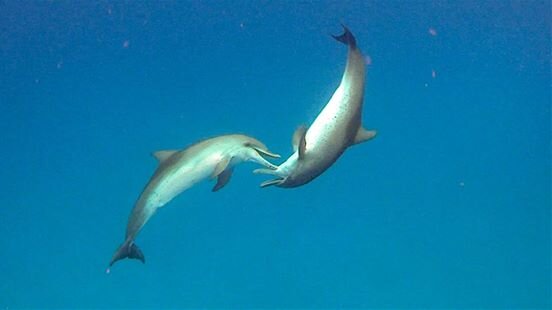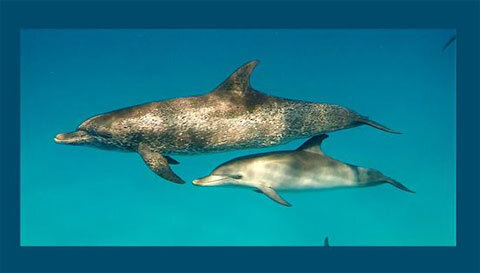Swimming With Dolphins
In July of 2014 my daughter Jess and I spent a week in the Bahamas swimming with wild spotted dolphins. She’d gone on a shark dive in March and discovered that a charter captain who took divers to the sharks all winter took swimmers to the dolphins all summer. She sent me the website, and I signed us up straightaway.
What was I thinking? That I’d jump in the water and dolphins would crowd around me singing “I Love You” in whatever dialect spotted dolphins speak? It wasn’t like that at all.
The boat was a converted fishing trawler that slept eighteen: twelve guests, Captain Scott and family (husband and wife and their eight-year-old daughter), two deck hands and a cook. The cabins were tiny, with double bunks so close together it was impossible to sit up without clonking my head. There were two bathrooms for twelve people, but in fact it was rare to have to wait for one to come vacant. A large salon-cum-dining room was available for hanging out away from the sun, and there was lots of room (some of it covered) on deck. Inside was thankfully air-conditioned; outside, the air was thick enough to drink.
So. Not fancy, but comfortable. The food was fabulous, and after hours in the water every day we ate like animals. But the best thing about the boat, especially during Hurricane Arthur, was its stability. Even in a six-foot swell, we could walk around without falling over.
Amenities aside, what made the trip special was Captain Scott Smith. Captain Scott grew up on fishing boats and made a connection with the spotted dolphins near Bimini when he was a teenager. He played with them often and got to know them well, but he didn’t realize it was something special until a new mother left her baby with him while she went hunting. Dolphins leave their babies with other dolphins. Not with humans.
Scott has been studying the dolphins since 1986, documenting them, recording what he can of their lives, and playing with them in the water. Spotted dolphins really love to play.
The dolphin excursions on Scott’s charter/research boat are booked out 2-3 years in advance. We were scheduled for a trip in mid-July 2015 but got bumped up to the end of June this year because of a pair of cancellations. I had five weeks to get ready.
I had no gear, so had to buy the snorkel, mask and fins. I blew an extra $200 to put prescription lenses in the mask (what’s the point of swimming with dolphins if you can’t see?), got a new-fangled “dry snorkel” that didn’t work any better than the old-fashioned kind, and tried out three different pairs of fins. Normal fins were hard on my self-dislocating kneecaps, so I tried split fins. They were better, but they had to be ordered in my size. They arrived the day before we left and were enormous. It turns out that the fin size increases with the foot size. Who knew?
There was a lot of discussion about wetsuits. Could I manage without one? Consensus said no, but I didn’t want one. They’re stiff and hard to manage. In the end I rented one but didn’t use it.
Then came the lessons. I wanted to be as technically au courant as possible, and took some lessons in a local lake. It was still bloody cold, so I wore a 7-mm wetsuit that was so buoyant I could barely swim. If I lay on my stomach, the suit shoved my head under the water. “Use your core!” yelled the instructor. I did, and it helped, but not enough. Even with a 14-lb. weight belt, I couldn’t stay under the water.
Still, the lessons were useful. I learned what I could and was pretty sure it would be enough.
Judith & Jess snorkeling | Photo courtesy Mary Cunningham-Walsh
Jess and I flew JetBlue to West Palm Beach a day and a half early. The airline has a nasty record of cancelled departures, and Captain Scott said the boat would sail at 7:00 p.m. sharp. Late-comers would be left behind. (Of course it didn’t work that way. We waited until 1:30 a.m. for the Japanese guide’s girlfriend’s plane to arrive from Tokyo.)
Anyway, we had extra time, so we tried out our gear, snorkeled the Hilton’s beach reef (pathetic) and swam the snorkel trail under Blue Heron Bridge. The gear worked fine. I was comfortable in the water, knew what to do, and everything was hunky-dory.
We checked out of the Hilton, taxied to the boat and filled out pages of forms, including customs forms for the Bahamas. That’s when we met the Western half of the passenger list. Sally and Mary, two friends from California, were experienced snorkelers and took amazing photos. I tried taking some myself and got a good shot of someone’s flipper, but that was about it.
It was Sally’s sixth time on the boat with Scott, and whenever she got in the water the dolphins mobbed her. Tess was another fine photographer and generous with her photos. It was her first time too, and, like me, she was a little apprehensive about how the whole swimming-with-dolphins-thing would play out.
A young Australian couple, Amy and I-forget-his-name, had been working in Canada for a year and were on their way home. They were not prepared, and stopped swimming halfway through the trip. Unlike many Australians, they were not game for almost anything.
At about nine o’clock, four-fifths of the Japanese contingent showed up: two adorable teenyboppers, their 50-ish chaperone Kaoru, and their very dishy tour leader Kentaro, who could sit on the bottom taking video for many minutes without coming up for air. Imagine how long he could stay underwater if he wasn’t a smoker!
This was when I realized I was eighteen years older than the next-oldest person on the boat. How was I going to manage?
During a random conversation Tess remarked that she’d been practicing free diving for four months, and though she could hold her breath for two minutes in the swimming pool, she couldn’t do it under pressure in the ocean.
Free diving? Two minutes? Pressure?
I had no idea what she was talking about, but it sounded like trouble. I ran through the info sheet Scott had sent. We needed to swim well enough to go down and up with the dolphins. That didn’t sound too difficult, but I was beginning to wonder. What, I asked, was free diving. Tess explained it meant diving without tanks and swimming under water. How else was I going to swim with the dolphins?
Good question. Pity I hadn’t asked it sooner.
Kentaro’s girlfriend finally arrived. We all went to bed, and the Dolphin Dream II set off for Bimini.
The first day, we traveled to where the dolphins were usually to be found. At around five o’clock Captain Scott dropped anchor, and everyone put on their fins, masks and snorkels. Within a few minutes the lookout yelled “Dolphins!” and we all jumped off the boat. Thankfully I’d learned how to do that in my lessons, along with how to defog the face mask and attach the snorkel.
Photo courtesy Sally Bartel
A knot of excited dolphins met us, rushing over to Sally to welcome her back and saying hi to Kentaro and his girls. They dove under the water and everyone—except for the Australians and me—followed them down. I hung out on the surface and watched through my mask.
There was a lot of in and out of the boat, as dolphins left and others came around for a chat. Jess quickly got the hang of the down part while I was pretty well stuck on the surface.
At the end of the session, Jess told me I’d done a wonderful job and everyone was very impressed. Impressed with what? I asked. You kept jumping in, she said. That and $2.50 will get me a ride on the NYC subway, I thought. But I didn’t say it. Meanwhile, one of my shipmates had a great time swimming with a dolphin for what she said was a long, long time. I was jealous.
Next morning Captain Scott took the boat around the likely spots, and shortly after breakfast we heard the call again. “Dolphins!” Everybody jumped in. Today Mrs. Captain took a “scooter” to the 30-foot bottom and had it run her around in circles. Apparently dolphins love circles, or maybe they just loved her, but at least ten of them followed her and the scooter around. When they came up for air the dolphins would flirt with swimmers on the surface, who followed them back down.
We did a little snorkeling that afternoon. Some pretty fish, but like most reefs in the Caribbean, this one was dead. Something about changing acidity in the oceans. I guess the colorful corals and reef creatures are a thing of the past. What a bummer.
The dolphins came back later that afternoon, and I started seriously trying to get down to their level. Turns out I am almost as buoyant without a wetsuit as I am with one. Someone suggested a weight belt to help me get down easier, but Mrs. Captain said no. Weights might make it easier to dive down deep, but maybe not so easy to come back to the surface. Fair enough.
Hurricane Arthur visited us that night, and the next day the sea was very rough. Being in the water was fine, but getting back on the boat was not so easy. The ladder was flipping around in the swell, and I got some solid whacks on my shins. It was great incentive to learn to climb the ladder backwards.
The dolphins came and went that day. They were attracted to the scooter and its circles, and I started getting cranky about their fixation on the machine. I wanted them on the surface where I was. I made some progress with the diving, but the waves messed up my timing with the snorkel and I inhaled and swallowed a lot of water.
Photo courtesy Sally Bartel
I saw a dolphin swimming with her baby several times that day, but didn’t think much of it. Sometimes the dolphins came in a big group, sometimes just two or three. If it was a small group, that pair was always present. Once or twice it was just the two of them.
The sea was even rougher that night. The Australian couple swam in the morning, then basically opted out. I kept on trying, telling myself it wasn’t that the dolphins hated me, I just couldn’t get down to where they were.
Then it happened. I dove under the waves, and the mother and baby were swimming next to me. No one else was around to push me out of the way or hit me in the face with a flipper. I swam for as long as I could hold my breath, with the dolphins swimming in slow motion. I could almost hear the mother saying, Come on, Judith. You can do this!
And, for a short time, I could.


